
Concept explainers
(a)
Interpretation:
The product formed when
Concept Introduction:
Pyridine is a heterocyclic compound which contains nitrogen atom. Pyridine nitrogen atom contain a lone pair. The lone pair of pyridine is not involved in the resonance with the
Answer to Problem 26.27AP
The product formed when
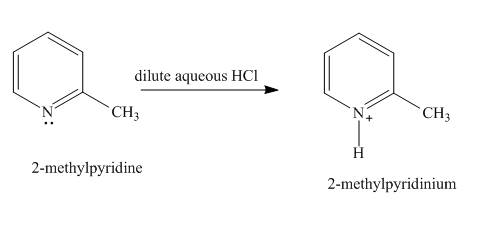
Explanation of Solution
In the given compound, the lone pair of the pyridine nitrogen is not involved in the resonance with the ring. Pyridine acts as base in the presence of acid. The nitrogen abstracts the proton from acid. The product formed is

Figure 1
The product formed in the given reaction is
(b)
Interpretation:
The product formed when
Concept Introduction:
Pyridine is a heterocyclic compound which contains nitrogen atom. Pyridine nitrogen atom contain a lone pair. The lone pair of pyridine is not involved in the resonance with the aromatic ring. No delocation of electron takes place, hence pyridine acts as a base. The hydrogen atoms of pyridine ring are not highly acidic, so mild base can’t abstract proton from pyridine. It requires a strong base for abstraction of proton.
Answer to Problem 26.27AP
No reaction takes place when
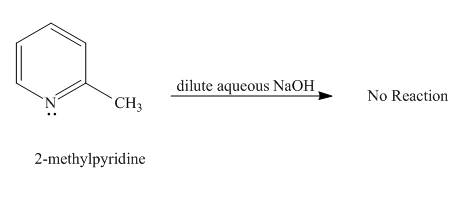
Explanation of Solution
Protons of pyridine are not highly acidic in nature. Sodium hydroxide cannot abstract proton from pyridine. It requires a very strong base for the removal of proton from pyridine to takes place. Hence, no reaction takes place between

Figure 2
No product is formed in the given reaction.
(c)
Interpretation:
The product formed when
Concept Introduction:
Pyridine is a heterocyclic compound which contains nitrogen atom. Pyridine nitrogen atom contain a lone pair. The lone pair of pyridine is not involved in the resonance with the aromatic ring. No delocation of electron takes place, hence pyridine acts as a base. The hydrogen atoms of pyridine ring are not highly acidic, so mild base can’t abstract proton from pyridine. It requires a strong base for abstraction of proton.
Answer to Problem 26.27AP
The product formed when

Explanation of Solution
The butyl-lithium compound is a very strong base. It will abstract proton from the methyl group of

Figure 3
The product formed in the given reaction is
(d)
Interpretation:
The product formed when
Concept Introduction:
Nitration reaction is aromatic electrophilic substitution reaction. The nitrating mixture contains nitric acid and sulfuric acid. The nitrosonium ion is formed as electrophile. The methyl group is an activating group, so it promotes electrophilic substitution reaction at ortho-para position.
Answer to Problem 26.27AP
The product formed when

Explanation of Solution
The compound

Figure 4
The product formed in the given reaction is
(e)
Interpretation:
The product formed when
Concept Introduction:
Pyridine is a heterocyclic compound which contains nitrogen atom. Pyridine nitrogen atom contain a lone pair. The lone pair of pyridine is not involved in the resonance with the aromatic ring. Hydrogen peroxide is a strong oxidizing agent. It will oxidize the nitrogen atom of pyridine to form
Answer to Problem 26.27AP
The product formed when
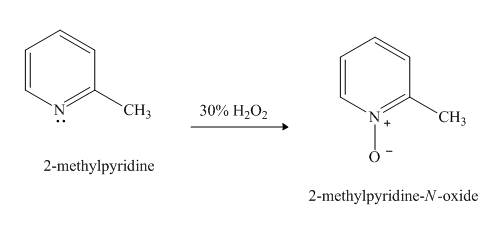
Explanation of Solution
Hydrogen peroxide is an oxidizing agent. It will oxidize the given compound. The oxidation reaction takes place at the nitrogen atom.

Figure 5
The product formed in the given reaction of
(f)
Interpretation:
The product formed when
Concept Introduction:
Pyridine is a heterocyclic compound which contains nitrogen atom. Pyridine nitrogen atom contain a lone pair. The lone pair of pyridine is not involved in the resonance with the aromatic ring. No delocation of electron takes place, hence pyridine acts as a base. The nitrogen atom lone pair attacks the methyl group of methyl iodide.
Answer to Problem 26.27AP
The product formed when
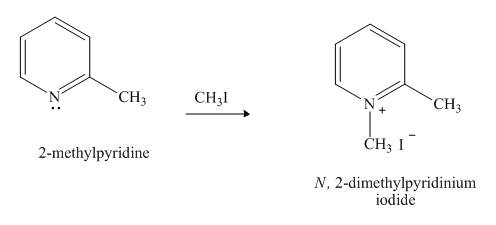
Explanation of Solution
The lone pair of nitrogen atom of pyridine is not involved in the resonance with the aromatic ring. The lone pair makes the pyridine compound basic in nature. When compound

Figure 6
The product formed in the given reaction of
(g)
Interpretation:
The product formed when
Concept Introduction:
Pyridine is a heterocyclic compound which contains nitrogen atom. Pyridine nitrogen atom contain a lone pair. The lone pair of pyridine is not involved in the resonance with the aromatic ring. No delocation of electron takes place, hence pyridine acts as a base. Lithiated pyridine compound reacts with
Answer to Problem 26.27AP
The product formed when
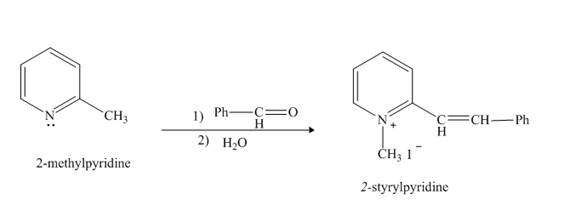
Explanation of Solution
The lithiation product formed reacts with benzaldehyde, nucleophilic addition reaction takes place to form

Figure 7
The product formed when
(h)
Interpretation:
The product formed when
Concept Introduction:
Pyridine is a heterocyclic compound which contains nitrogen atom. Pyridine nitrogen atom contain a lone pair. The lone pair of pyridine is not involved in the resonance with the aromatic ring. Hydrogen peroxide is a strong oxidizing agent. It will oxidize the nitrogen atom of pyridine to form
Answer to Problem 26.27AP
The product formed when
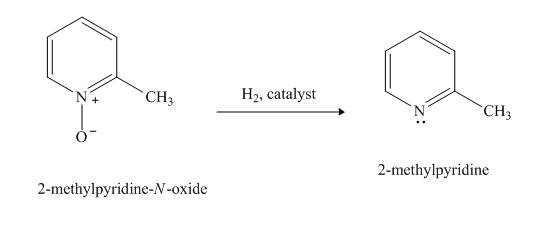
Explanation of Solution
The compound

Figure 8
The product formed when
Want to see more full solutions like this?
Chapter 26 Solutions
Organic Chemistry Study Guide and Solutions
- In the decomposition reaction in solution B → C, only species C absorbs UV radiation, but neither B nor the solvent absorbs. If we call At the absorbance measured at any time, A0 the absorbance at the beginning of the reaction, and A∞ the absorbance at the end of the reaction, which of the expressions is valid? We assume that Beer's law is fulfilled.arrow_forward> You are trying to decide if there is a single reagent you can add that will make the following synthesis possible without any other major side products: 1. ☑ CI 2. H3O+ O Draw the missing reagent X you think will make this synthesis work in the drawing area below. If there is no reagent that will make your desired product in good yield or without complications, just check the box under the drawing area and leave it blank. Click and drag to start drawing a structure. Explanation Check ? DO 18 Ar B © 2025 McGraw Hill LLC. All Rights Reserved. Terms of Use | Privacy Center | Accessibilityarrow_forwardDon't use ai to answer I will report you answerarrow_forward
- Consider a solution of 0.00304 moles of 4-nitrobenzoic acid (pKa = 3.442) dissolved in 25 mL water and titrated with 0.0991 M NaOH. Calculate the pH at the equivalence pointarrow_forwardWhat is the name of the following compound? SiMe3arrow_forwardK Draw the starting structure that would lead to the major product shown under the provided conditions. Drawing 1. NaNH2 2. PhCH2Br 4 57°F Sunny Q Searcharrow_forward
- 7 Draw the starting alkyl bromide that would produce this alkyne under these conditions. F Drawing 1. NaNH2, A 2. H3O+ £ 4 Temps to rise Tomorrow Q Search H2arrow_forward7 Comment on the general features of the predicted (extremely simplified) ¹H- NMR spectrum of lycopene that is provided below. 00 6 57 PPM 3 2 1 0arrow_forwardIndicate the compound formula: dimethyl iodide (propyl) sulfonium.arrow_forward
 Chemistry: Principles and ReactionsChemistryISBN:9781305079373Author:William L. Masterton, Cecile N. HurleyPublisher:Cengage Learning
Chemistry: Principles and ReactionsChemistryISBN:9781305079373Author:William L. Masterton, Cecile N. HurleyPublisher:Cengage Learning

